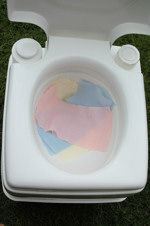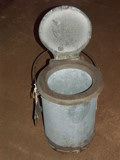How to use Motorhome Chemical Toilets

How to use Motorhome Chemical Toilets
Ten years ago the "walk of shame" was left by many as a (blue-collar) job to do in the hours of darkness. Some people even today are scared off by the prospect of using a toilet when camping, but in recent years it's become a pleasant experience, depending on which way you look at it. ;) Personally, I used to be intimidated by the whole process, but after three or four times it became rather satisfying (WHY? I hear you ask) Topping up with fresh water and emptying the toilet cassette before leaving a campsite, is like driving a car that has been thoroughly cleaned and waxed and as we all know a car in that state drives like a dream! Nearly all campsites have ultra-clean, and I mean ultra-clean "Elsan points" or toilet emptying facilities, with air fresheners, hand washing basins, a hose to rinse the cassette out and a flush mechanism similar to your toilet at home.
 Smells
Smells

The days of foul-smelling chemical toilets and unpleasant emptying areas are long gone. Modern cassettes are easy to clean and even easier to empty with the shortest glimpse of the contents gliding into the oversized bowl never to be seen again. The cassettes have a pressure equalising button near the handgrip that allows air in as the contents flow out and prevents the glugging sound and more importantly the dreaded splashback.
Chemical toilets come in several forms.
Thetford's Porta Potti line is ideal for securing waste in a holding tank. The Porta Potti style is divided into two sections. The upper piece includes a detachable seat and cover, as well as a combined flush-water tank and toilet bowl. The waste holding tank is located in the lower part. The two sections readily separate, allowing you to simply and hygienically dump the waste.

The cassette is usually placed behind a secured panel on the outside of the caravan or motorhome, where it can be removed.
Some toilets may have a swivel bowl to maximise the valuable real estate in the bathroom area, and the flush may be powered by the unit's pump recreational batteries or the site's electric hook-up. Some toilets have a separate smaller flushing water tank with a level indicator.
Tanks and Flushing
Toilets and holding tanks, like so many other things in the camping and caravanning world, come in a variety of shapes and sizes, ranging from the most basic bucket-with-seat to a plush cassette unit with an electric flush and a ceramic bowl. Many factors will impact your decision, including your means of transport to the site, the volume of waste you expect to collect, and – at the top end – your ability to flush your toilet with electricity.
Take the time to study the instruction booklet for the toilet you choose and make sure you understand how to use it properly. This could mean the difference between a pleasant vacation and one that is a little more smelly.
To give you an idea of how much tank space you'll need, imagine a couple who only used a chemical toilet and never used the camping facilities. They'd probably fill a 20-litre tank in three days.
Which Chemical
Choose your toilet chemicals wisely because they all work differently. Some kill bacteria, while others employ a biological process to break down waste, and the majority use perfume to cover any odour. Many people use a combination of the two. Many websites, including certain Club websites, may ask that you only use environmentally friendly chemicals.
The main toilet chemical goes into the waste tank. These compounds are available in a range of shapes and sizes. The popular form is a fluid that must be diluted with water. Chemicals in tablet form – or even 'liquid tablets' like the cleaning agents for your washing machine – are usually more expensive, so you may decide that the convenience outweighs the extra cost.

If you're using a flushing toilet, such as those found in caravan and motorhome washrooms, you may want to add a chemical to the water in the flush-water tank. Named after the colour of the early flush-water tank fluids, this chemical is commonly referred to as the 'pink' chemical.
Most toilet fluids lose their effectiveness after three days, so it's important to empty your toilet or refill it with fresh fluid on a frequent basis.
Go Outdoors has a good selection of chemical toilet liquids, and you may save money on them with its rewards card and Club membership.
Do not put anything else down your toilet
It should go without saying that only human waste should be flushed down the toilet. Disposable nappies, as well as any other similar goods, should never be flushed into the tank. A blockage in the toilet or the tank can only be fixed one way!
When it comes to toilet paper, most toilet chemical providers advocate using 'rapid dissolve' toilet paper with your unit. This may be a nice idea if your family uses a lot of paper, but in most circumstances, regular toilet paper will suffice and will almost definitely be less expensive.
Disposing of your chemical toilet waste
The Prime Rule of chemical toilets is that they must only be emptied in certain locations. Aside from the obvious sanitary concerns, the chemicals should not be dumped directly into the sewer system.

You should never, empty your black waste (toilet cassette contents) in a greywater waste disposal point and also, keep it away from any source of freshwater.
The waste is held in a sealed cassette unless you use the most basic 'bucket and dump it's style system'. The instruction booklet for your unit will show you where to find this button.
Bombs Away Odd Chap!
In the 1920s, Elsan was the first to bring the chemical toilet to the market, and for some, the term "Elsan" has come to refer to both toilet fluid and chemical toilets. During WWII, an Elsan was the only 'convenience of choice for air raid shelters and bomber crews.
Because of the brand's history and popularity, several campgrounds now refer to their Chemical Disposal Points as Elsan Disposal Points.

Top Tip - Flowers at the end
Finally, here's a sensitive tip: don't read any further if you're easily offended.
Lining the bowl with three pieces of toilet paper around the bowl before use will help keep it clean.


